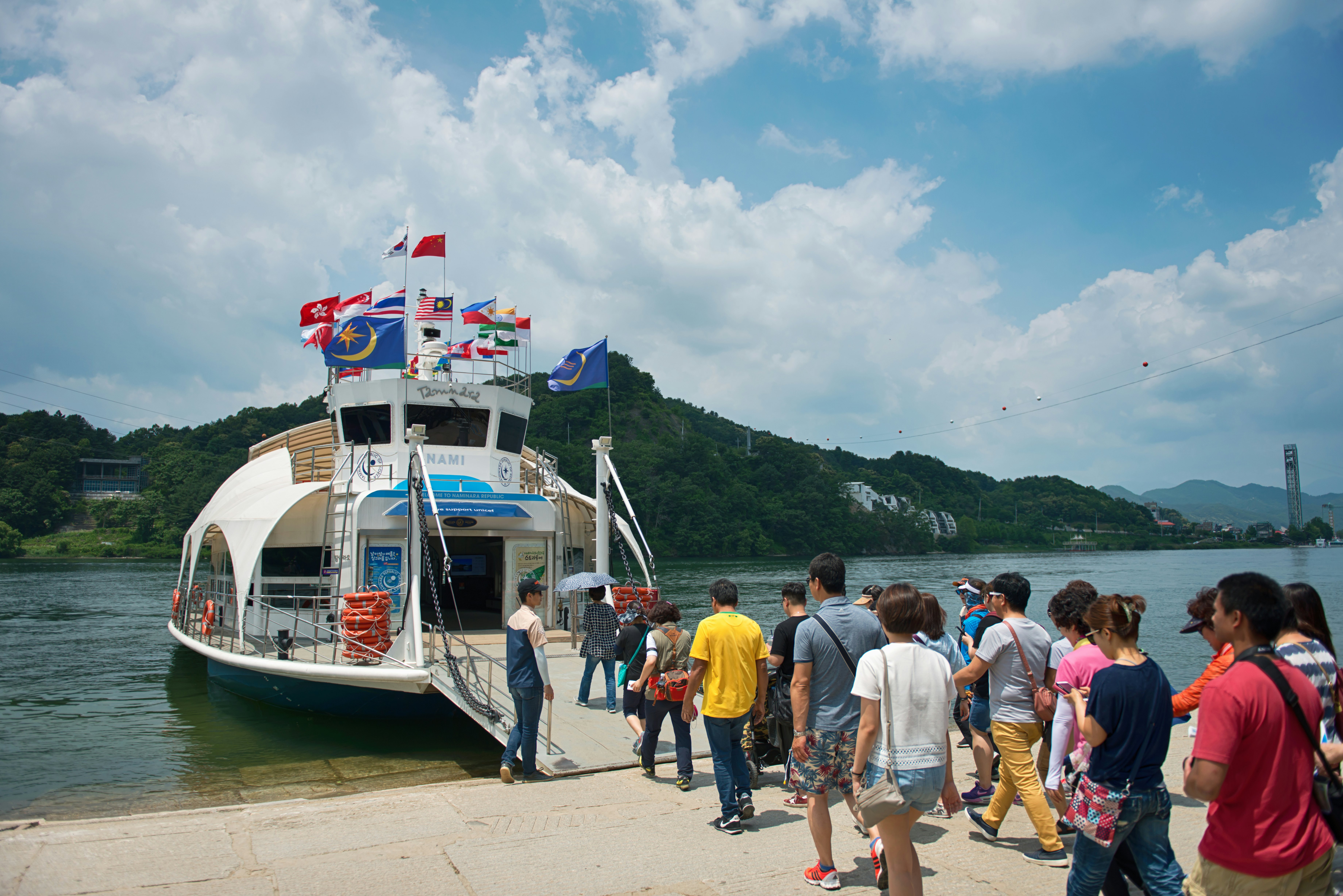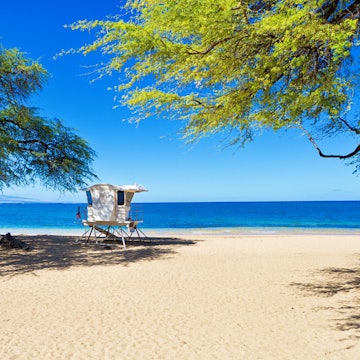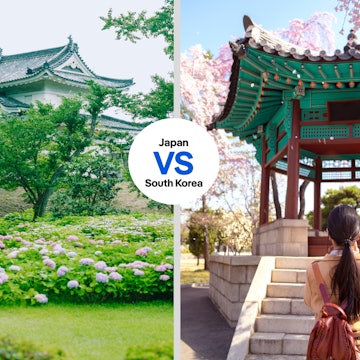
Everything you need to know about getting around South Korea

Feb 17, 2024 • 8 min read

Passengers on sightseeing trains, or V-Trains, can experience breathtaking views from the train's huge windows © PixHound / iStockphoto
There aren't many destinations that make getting around as easy as South Korea does – it's a gift to travelers who love to explore on their own schedule.
Its relatively small size combined with some of the best transportation infrastructure in the world allows everyone to get from here to there with minimal hassle and expense. Compared to countries with similar economic standing, Korea's trains, buses and taxis are also surprisingly cheap.
They truly are the gold standard when it comes to public transport – high-speed rail connects cities across the peninsula, buses reach every corner of the country, and boats ferry travelers to islands scattered off the west coast.
In cities, subway systems and local buses will carry you anywhere you want to go, while bike-sharing systems are increasingly becoming a viable option. If you decide to rent a car and hit the open road, you'll find a well-maintained – if sometimes crowded – road system. Here's everything you need to know about getting around South Korea.
Buy a transportation card to make life easier
One of the first things you should do upon arriving in South Korea is purchase a rechargeable transportation card. They're cheaper than buying single-journey tickets and allow you to transfer between buses and the subway for free.
There are three types of cards: NAMANE, Tmoney and Cashbee (also known as the Korea Travel Card). NAMANE and Tmoney are slightly better options for most travelers because they're accepted everywhere, whereas buses in some southern regions don't take Cashbee. NAMANE can be purchased via an app or in designated kiosks at transport hubs; you can top up your card on the app anytime. Tmoney and Cashbee cards can be purchased at convenience stores and recharged there or at subway station charging machines, but Tmoney cards can also be purchased from machines in subway stations.
You can also use your transport card in many taxis and even some businesses. Just look for their logos displayed in windows or on the card reader.
Catch a flight to visit Jeju-do
South Korea has some internal flights, but it only makes sense to fly domestically when traveling to and from Jeju-do. In Seoul, all flights to and from Jeju City operate out of Gimpo International Airport on the city's west side. Flying time is one hour, and you can usually snag a round-trip ticket for around ₩81,000.

Explore Korea's islands by ferry
Many of South Korea's islands can only be reached by boat. Most ferries to the islands off the coast of Incheon depart from the Incheon International Ferry Terminal, while most ferries to southwestern islands depart from the Mokpo Ferry Passenger Terminal.
If you'd prefer to sail to Jeju-do rather than fly, you can do so from numerous ports along the south coast, including Mokpo and Busan. Ferry tickets can be booked online at Gabogosipon-Seom, but the website is only in Korean. Buying a ticket at the terminal before departure is rarely a problem and is your best bet if you don't speak Korean well.

Travel between cities by train
KORAIL operates Korea's rail system, and it's the best way to travel between major cities. From Seoul, the main routes run southwest toward Mokpo and southeast toward Busan.
KORAIL runs three main types of trains. The fastest are high-speed KTX trains that reach speeds of 330km/h (205mph) and travel from Seoul to Busan in just over two hours. Saemaeul trains are slightly slower, and Mugunghwa trains are the slowest, but they're comfortable and stop at the smaller stations that other trains bypass. Unsurprisingly, the faster you want to go, the more your ride will cost, but even KTX tickets are reasonably priced.
Train tickets can be purchased from machines or ticket counters at train stations or online via the KORAIL website. International travelers who plan to take multiple train trips may want to purchase a KORAIL Pass, which can be used on all trains and is valid for either three or five consecutive days, or two or four selected days within a 10-day period.
Catch a bus to smaller towns and for short trips within cities
Intercity buses are a great way of getting around Korea and can get you to many places trains can't. Just about any town you'd want to visit is reachable within a transfer or two. The downside is that buses are subject to South Korea's often maddening traffic, though dedicated bus lanes make this less of an issue on certain highways.
Intercity bus tickets can be purchased on KOBUS, BusTago and Tmoney Bus. However, all three have issues with some combination of not accepting international credit cards and only allowing purchases to be made on the Korean version of the site, making them rather unhelpful for travelers. Fortunately, buses are frequent, and tickets are typically readily available for purchase from machines and counters in bus stations.
Bus systems in cities and towns will usually display basic English info, either at stops or onboard, but that's not always the case in rural areas. KakaoBus is a useful app that provides route and arrival info for buses and bus stops across the country, though not all information is provided in English.
How to find a taxi in South Korea
Taxis in Korea are convenient and cheap, with daytime fares starting around ₩3500. Many cabbies understand basic English, but if you're nervous about getting your point across, look for a cab designated as an International Taxi, whose drivers can speak one or more foreign languages, or book a cab on the International Taxi website.
You'll find taxis lined up outside train and bus stations and cruising main streets. Available taxis will have their roof light on and a sign on the windshield saying "빈차" (empty car). A bit confusingly, the sign is red, while the sign indicating the car has been reserved is green. It's also possible to call to reserve a taxi. Most services are in Korean only, but you can call Korea's Travel Helpline (1330), and someone will provide interpretation services. You can pay for your ride with cash, a credit card or often a transportation card. Drivers don't expect a tip, but rounding up to the nearest ₩500 or ₩1000 is appreciated.
Ride-sharing services in Korea function a bit differently than you might be used to, in that they're just a way to call a cab. Uber can be used to call either a regular taxi or a taxi operated by Uber in conjunction with its South Korean partner company. The most popular ride-hailing app in Korea is Kakao T, which is also used to call a regular taxi.

For urban exploration, hop on the subway
Five cities in Korea have metro systems: Seoul, Busan, Daegu, Daejeon and Gwangju. Daejeon's and Gwangju's subways consist of just one line each, while Seoul's network is a sprawling behemoth of 23 lines that also serve cities throughout Gyeonggi-do Province, including Incheon and Suwon.
Korean subway systems are simple to use, even Seoul's. All signage and stop announcements are in Korean and English (and often Chinese and Japanese), and both train arrival times and transfer directions are clearly displayed. A helpful app for planning routes across all five metro systems is Subway Korea.
If you don't like your air conditioning too cold, look for signs on the platform safety doors that read 약냉반 or 약냉반칸. These indicate that the corresponding cars have weaker AC than other parts of the train.
In many stations, platform safety doors will have small maps showing the entire length of the subway line you're waiting for, with colored arrows indicating where you can transfer to other lines. If you're in a rush, look for the small two-digit number next to the arrow of the line you want to transfer to. This will tell you where to board your train to have the shortest walk at the interchange station. For example, if the two-digit number reads 7-2, you'll minimize your transfer time by boarding car seven at door two.
Driving will get you to Korea's hidden corners
In most places in South Korea, public transportation is a more convenient and comfortable option than driving. Renting a car only makes sense if you're looking to get well off the beaten path, plan a road trip, or travel on Jeju-do.
South Korea has good road infrastructure, and many signs are in Korean and English. Google Maps doesn't work particularly well in Korea, but Kakao Map is a reasonably foreigner-friendly alternative.
Accessible transportation in South Korea
There's great variation in how accessible transportation is across South Korea. In urban areas, travelers with disabilities usually have recourse to at least one option. However, the more rural your trip gets, the more challenging things become.
Traveling to and from Incheon and Gimpo airports is simple, as all AREX trains and stations are fully accessible. In Seoul, the subway system is well-equipped to serve passengers with disabilities. All stations are accessible; though, at some older and smaller stations, this may mean wheelchair lifts instead of elevators (As the oldest line in the system, Line 1 will be the toughest to navigate).
Each subway car has a reserved seating area for older adults, pregnant women and passengers with disabilities. Each train also has a few cars with areas set aside for wheelchairs, and their locations are denoted with large wheelchair signs on the floor or on the safety doors where you board. Subway trains provide audio and visual stop announcements in Korean and English.
Some buses in Korea – though by no means all – are low-floor buses that have no steps where you board and disembark. Some will also have places to store wheelchairs. In cities, buses almost always provide bilingual audio and visual stop announcements.
Another option in many cities is wheelchair-accessible call taxis. In Seoul, these can be booked via the International Taxi website or the phone number or email listed on the site.
Another good resource in the Korean capital is Seoul Danurim, a tourism information center dedicated to assisting travelers with disabilities. For more information on accessible travel, check out Lonely Planet's accessible travel resources.















